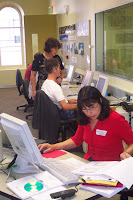

Toronto: N: 43º 39.391' W: 079º 22.833'
During the two days I have been in Toronto I have been checking out the spatial technology scene in Canada to see if the commentary will be any different to what I found in the US in regards to the implementation of GIS into schools. Whilst the story seems slightly different much of the discussion still revolved around the difficulties in getting the use of spatial technology integrated in a meaningful way across the curriculum and the difficulty in getting teachers up to speed with the technology.
This morning I ventured out on the subway to the ESRI Canada offices to meet Jean Tong, ESRI Canada K-12 Industry Manager. Like Mick Law in Australia, Jean is a teacher who has recently taken the plunge out of the classroom to work in the area of GIS education within the spatial industry. Jean arranged for one of the key players in GIS Education in Canada, Mark Lowry to meet with us over lunch and back at the office. Mark is the Geography, Geotechnology and Civics Instructional Leader with the Toronto District School Board. As well as developing teaching materials, writing courses and training teachers in GIS across Ontario, Mark has also been working in Hong Kong and Jordon in the Middle East developing GIS based curriculum and training teachers. The breadth of Marks involvement in GIS education over many years was a real eye opener and his philosophy meshed very well with what we have been thinking in Australia about the place and approach to spatial technology in schools. Mark and Jean shared their thoughts on the successes, limitations and future of spatial technology in Canadian schools. Here is a brief summary of the discussion:
Successes
• Ontario is the eighth largest school district in North America with over 2 million students. Hence the fact that the Ontario District School Board has purchased a state site license is a great start. Other states with a state wide license are British Columbia (600,000 students), Manitoba (200,000 students) and Nova Scotia (35,000 students). In Australia our states have not broached the statewide license with ESRI but it certainly would provide a head start if each school had access to the software without convincing the school budget committee that it is a necessary purchase.
•The ESRI Canada website is well used and provides enormous support to teacher implementing GIS. It is worth having a look at the site at http://www.esricanada.com/english/3478.asp Plenty of lessons, free downloadable data and resources at http://www.esricanada.com/english/3780.asp
•Jean and her education team have been involved in producing a really useful DVD provided to all ESRI site license schools called ArcCanada 3.0. The DVD provides heaps of Canadian and world data for the classroom. Another CD available to Canadian schools using ESRI products is the Atlas Ontario product (http://www.esricanada.com/english/3715.asp) which provides a collection of data and lesson ideas aimed at supporting the new Geography curriculum in Ontario.
•The Ontario District School Board has overtly written the knowledge of GIS into the 6-12 curriculum which has provided to a certain extent the sanction and stimulus to train teachers. For example it is quoted saying "... identify and describe the technologies used in geographic enquiry e.g.geographic information systems, gps etc"
* Mark went through the new Geography 11-12 curriculum which has a wide variety of geography course options. One of these is called Geomatics and focusses on the use of spatial technology. For more information on these courses go to http://www.edu.gov.on.ca/eng/curriculum/secondary/canworld1112curr.pdf
*Year 8 and 9 geography and Year 10 history is mandatory in Ontario (http://www.edu.gov.on.ca/eng/curriculum/elementary/sstudies78ex/). This gives plenty of opportunity for all students to be exposed to GIS. Interestingly much of the same language and focus is evident in the curriculum documents to what we have in Society and Environment across Australia (as was the case in Hong Kong as well). There seems a universal history, geography and civics educational “speak”. It seems the approach is where the difference often exists and in turn teacher interpretation of the document and resulting pedagogy.
Limitations
* Even though GIS is overtly mentioned in the 6-12 curriculum documents the reference can involve only a cursory treatment of spatial technology by schools if so desired. GIS is not an assessment item and the treatment is not specified in any way other than awareness of the technology and not necessarily its application in the classroom.
* With Year 10 history being mandatory very few schools do Year 10 geography.
* Even though there is a plethora (16 courses in total) of great geography/history courses available at year 11-12, 85% of students choose the 'World Issues' and 'Travel and Tourism' units. Geography numbers are holding in year 11 and 12 but not increasing.
* Mark and others have been busy training teachers but there is still limited penetration across the teaching spectrum. Again, the training is mainly of the motivated and energised with many teachers finding it difficult to find the time to commence the learning curve. Sounds a familiar tale for this blog!
The future
* We spent some time looking at the free downloadable ArcGIS Explorer programme. Although the coverage of data for Australia is limited, shapefiles can be imported into the programme to cover Australia. This is a great programme free for those not aware. It can be downloaded from http://www.esri.com/software/arcgis/explorer/index.html Although free at the moment it seems very likely that the future of delivery to schools could be via such a webserver facility (data already is being made available to schools via the ESRI webserver as mentioned in a previous blog posting). Naturally such a download would be at a cost to schools but able to be frequently updated, easy to use instead of complex installation and cheaper for ESRI to deliver as a product and hopefully cheaper to schools.
* We also talked about the need to focus on spatial literacy and visual literacy skills and not just mapmaking by students. Such skills require a framework of problem solving and creative methodology by teachers as has been frequently discussed by others on my journey. Hopefully a focus on spatial literacy and associated teaching methods is the wedge to convince schools to take on spatial technology as a tool for learning. More on that later!








































